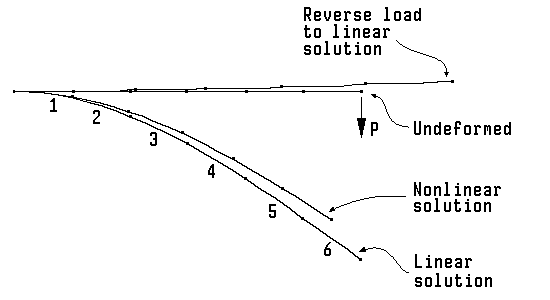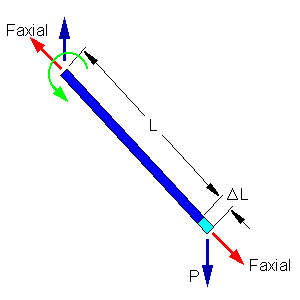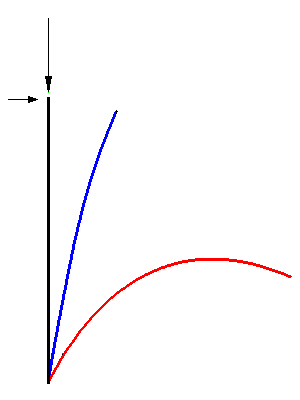 [STRAUS Applications] [STRAUS Specifications]
[STRAUS Applications] [STRAUS Specifications][STRAUS Users Page] [STRAUS Model Archive] [Technical Papers and Tips Contents Page]
[Technical Articles Contents Page] [Home Page] [Next Page]
 [STRAUS Applications] [STRAUS Specifications]
[STRAUS Applications] [STRAUS Specifications]
[STRAUS Users Page] [STRAUS
Model Archive] [Technical Papers and Tips
Contents Page]
[Technical Articles
Contents Page] [Home Page] [Next
Page]

Those who are beginning to venture into the demanding world of nonlinear analysis, will find that things are much more complicated than they are used to with linear analysis. The following is a "no maths" explanation of some of the important aspects.
Convergence
Since releasing the nonlinear solver, most of the support calls
we have taken, have had to do with convergence. Because nonlinear
problems are generally solved using an iterative procedure, the
level of convergence reached tells us the likely error in the
"solution". However, not all nonlinear problems are
guaranteed to converge but often convergence can be helped along
by modifying some of the parameters. An example of this is to
reduce the amount of initial load into the structure until it has
converged, then to progressively increase the load, instead of
applying it all at once.
There are a number of ways to check that convergence has been reached, such as monitoring the change in some parameter from one iteration to the next. STRAUS currently has two convergence criteria:
Basically the main difference between linear and nonlinear analysis is that in linear analysis, equilibrium is satisfied on the initial undeformed configuration, whereas in nonlinear analysis, equilibrium must be satified in the deformed configuration. To achieve final equilibrium in a nonlinear analysis, we solve the problem many times, constantly adjusting the applied forces based on the current state of equilibrim, and modifying the geometry based on the current displacements, until we reduce the residual forces to an acceptable level.
To illustrate the idea of residual forces, consider the following example. A tip loaded cantilever experiences a deflection as shown in the following figure.

The linear analysis indicates no axial movement in the beam, i.e. no shortening. If we take the deformed beam as the current configuration and apply the tip load in reverse, a linear analysis shows that the beam does not return to its original position. A free body diagram of deformed element 6 of the linear analysis, indicates that the internal loads are not in equilibrium with the external loads. This is mostly because the length of the element has increased. At the end of the first iteration, the nonlinear solver sees an element which has stretched, but no external force to cause the stretching. The residual loads are the difference between the applied loads and the internal loads. In this case most of the residual loads arise from Faxial marked below.

If you actually run this type of analysis in STRAUS, you will find that at the end of the second iteration, the residual loads are quite large. This is due to the apparent axial strain of the beam after the initial application of the load as shown in the free body diagram. Because the axial stiffness of a typical beam is much greater than its bending stiffness, any slight error in the axial strain will generate a large residual load. In this case, most of the residual load is associated with setting the current length of the beam back to its correct length. Typical residual force norms reported by STRAUS for this problem are as shown in the following table.
| ITERATION | Residual Forces Norm |
|---|---|
| 1 | 1.0 |
| 2 | 192.9 |
| 3 | 0.100 |
| 4 | 0.047 |
| 5 | 0.0001 |
If all you are concerned with is the deformed shape, then the residual forces norm can be relaxed and convergence dictated by the displacement norm only. If however, you are concerned with the stresses and forces/reactions in the structure, then it is important that the residual forces norm be enforced to a tighter tolerance.
Kg
The STRAUS nonlinear solver panel has an ON-OFF switch for
selecting Kg. This is only relevant to nonlinear geometric
analysis and should be set to off for material nonlinear
analysis. Kg stands for geometric stiffness matrix. It is
sometimes also called the stress stiffness matrix, or K. It is a
measure of the change in stiffness of an element due to membrane
forces.
Kg itself does not alter the final equilibrium of the structure. This means that a converged solution should give identical results irrespective of whether Kg is included or not. It can however aid convergence in problems where there are membrane loads. The elastica problem shown in the figure below will benefit from the inclusion of Kg during the first couple of increments. After that, the membrane loads are reduced as is the effect of Kg.

For problems where convergence is difficult to achieve, it is worth running it with Kg ON and with Kg OFF to gauge its effect.
Nonlinear plate/shell analysis
For beam and brick structures, we mostly find that convergence,
both displacements and residual loads, is fairly easy to achieve.
For plate/shell analysis, it can be more difficult.
One of the major difficulties with plates and shells has to do with the drilling freedom. The plate/shell elements have only 5 degrees of freedom per node, so that when we transform a plate to general 3D space, we are left with a zero rotational stiffness about an axis normal to the surface of the plate. This is usually trapped as a drilling freedom in STRAUS and some artificial stiffness added to allow the solution to proceed. The trapping process however, is based on some threshold value of what is to be regarded as a zero stiffness. Although STRAUS allows you to set this value, it is not necessarily true that the value will be appropriate over the entire solution. It may be correct for the first increment but not for subsequent ones.
For more information please contact us by
e-mail: hsh@iperv.it